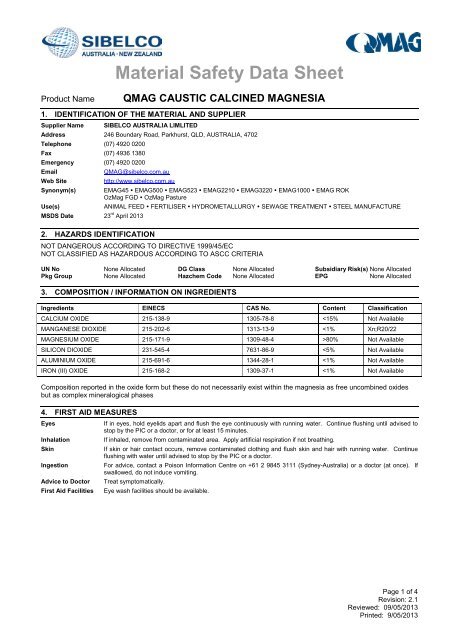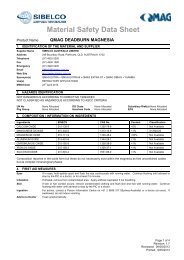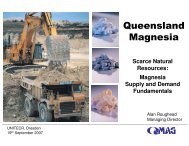MSDS - Material Safety Data Sheet for CCM products - QMAG
MSDS - Material Safety Data Sheet for CCM products - QMAG
MSDS - Material Safety Data Sheet for CCM products - QMAG
You also want an ePaper? Increase the reach of your titles
YUMPU automatically turns print PDFs into web optimized ePapers that Google loves.
<strong>Material</strong> <strong>Safety</strong> <strong>Data</strong> <strong>Sheet</strong><br />
Product Name<br />
<strong>QMAG</strong> CAUSTIC CALCINED MAGNESIA<br />
1. IDENTIFICATION OF THE MATERIAL AND SUPPLIER<br />
Supplier Name<br />
SIBELCO AUSTRALIA LIMLITED<br />
Address 246 Boundary Road, Parkhurst, QLD, AUSTRALIA, 4702<br />
Telephone (07) 4920 0200<br />
Fax (07) 4936 1380<br />
Emergency (07) 4920 0200<br />
Email<br />
Web Site<br />
Synonym(s)<br />
Use(s)<br />
<strong>QMAG</strong>@sibelco.com.au<br />
http://www.sibelco.com.au<br />
<strong>MSDS</strong> Date 23 rd April 2013<br />
2. HAZARDS IDENTIFICATION<br />
EMAG45 • EMAG500 • EMAG523 • EMAG2210 • EMAG3220 • EMAG1000 • EMAG ROK<br />
OzMag FGD • OzMag Pasture<br />
ANIMAL FEED • FERTILISER • HYDROMETALLURGY • SEWAGE TREATMENT • STEEL MANUFACTURE<br />
NOT DANGEROUS ACCORDING TO DIRECTIVE 1999/45/EC<br />
NOT CLASSIFIED AS HAZARDOUS ACCORDING TO ASCC CRITERIA<br />
UN No None Allocated DG Class None Allocated Subsidiary Risk(s) None Allocated<br />
Pkg Group None Allocated Hazchem Code None Allocated EPG None Allocated<br />
3. COMPOSITION / INFORMATION ON INGREDIENTS<br />
Ingredients EINECS CAS No. Content Classification<br />
CALCIUM OXIDE 215-138-9 1305-78-8
Product Name<br />
<strong>QMAG</strong> Caustic Calcine Magnesia<br />
5. FIRE FIGHTING MEASURES<br />
Flammability Non flammable.<br />
Fire and Explosion Non Flammable<br />
Extinguishing Non Flammable<br />
Hazchem Code None Allocated<br />
6. ACCIDENTAL RELEASE MEASURES<br />
Spillage<br />
7. STORAGE AND HANDLING<br />
Storage<br />
Handling<br />
If spilt (bulk), wear dust-proof goggles, PVC/rubber gloves and a Class P1 (Particulate) respirator (where a dust<br />
inhalation risk exists). Ventilate spillage area. Collect and place in sealable containers <strong>for</strong> disposal. Avoid<br />
generating dust.<br />
Store in cool, dry, well ventilated area, remove from interhalogens, phosphorous pentachloride and foodstuffs.<br />
Ensure product is adequately labelled, protected from physical damage and sealed when not in use.<br />
Be<strong>for</strong>e use carefully read the product label. Use of safe work practices are recommended to avoid eye or skin<br />
contact and inhalation. Observe good personal hygiene, including washing hands be<strong>for</strong>e eating. Prohibit eating,<br />
drinking and smoking in contaminated areas.<br />
8. EXPOSURE CONTROLS / PERSONAL PROTECTION<br />
Exposure Stds<br />
Ingredient<br />
Reference<br />
TWA<br />
STEL<br />
ppm mg/m3 ppm mg/m3<br />
Aluminum oxide (a) NOHSC (AUS) - 10.0 - -<br />
Calcium oxide NOHSC (AUS) - 2.0 - -<br />
Iron oxide fume (Fe2O3) (as Fe) NOHSC (AUS) - 5.0 - -<br />
Magnesium oxide (fume) NOHSC (AUS) - 10.0 - -<br />
Manganese, dust & compounds NOHSC (AUS) - 1.0 - -<br />
(as Mn)<br />
Manganese, fume (as Mn) NOHSC (AUS) - 1.0 - 3.0<br />
Biological Limits<br />
Engineering<br />
Controls<br />
PPE<br />
No Biological Limit Value allocated.<br />
Do not inhale dust / powder. Use with adequate natural ventilation. Where a dust inhalation hazard exists,<br />
mechanical extraction ventilation is recommended.<br />
Wear dust-proof goggles and rubber or PVC gloves. Where an inhalation risk exists, wear a Class P1 (Particulate)<br />
Respirator.<br />
9. PHYSICAL AND CHEMICAL PROPERTIES<br />
Appearance WHITE TO PINK SOLID Solubility (water) PRACTICALLY INSOLUBLE<br />
Odour SLIGHT ODOUR Specific Gravity >1.0<br />
pH NOT AVAILABLE % Volatiles NOT AVAILABLE<br />
Vapour Pressure NOT AVAILABLE Flammability NOT FLAMMABLE<br />
Vapour Density NOT AVAILABLE Flash Point NOT RELEVANT<br />
Boiling Point 3600 o C Upper Explosion Limit NOT RELEVANT<br />
Melting Point 2600 o C to 2800 o C Lower Explosion Limit NOT RELEVANT<br />
Evaporation Rate NOT AVAILABLE Autoignition Temperature NOT AVAILABLE<br />
Page 2 of 4<br />
Revision: 2.1<br />
Reviewed: 09/05/2013<br />
Printed: 9/05/2013
Product Name<br />
<strong>QMAG</strong> Caustic Calcine Magnesia<br />
10. STABILITY AND REACTIVITY<br />
Chemical Stability<br />
Conditions to<br />
Avoid<br />
<strong>Material</strong> to Avoid<br />
Hazardous<br />
Reactions<br />
Stable under recommended conditions of storage.<br />
No known conditions to avoid.<br />
Incompatible (violently or explosively) with interhalogens (e.g. bromine pentafluoride, chlorine trifluoride) and<br />
phosphorus pentachloride. This product will hydrate slowly when exposed to water.<br />
Polymerization will not occur.<br />
11. TOXICOLOGICAL INFORMATION<br />
Health Hazard Low toxicity – Irritant. This product may present a hazard with eye contact, prolonged or repeated skin contact, or<br />
Summary<br />
with dust inhalation at high levels. Use safe work practices to avoid eye or skin contact and dust inhalation.<br />
Eye<br />
Irritant. Contact may result in irritation, lacrimation, pain and redness.<br />
Inhalation<br />
Irritant. Over exposure may result in mucous membrane irritation of the nose and throat with coughing.<br />
Skin<br />
Irritant. Contact may result in irritation, redness, rash and dermatitis.<br />
Ingestion<br />
Low toxicity. Ingestion may result in gastrointestinal irritation, nausea, vomiting, abdominal pain and diarrhoea.<br />
Toxicity <strong>Data</strong> MANGANESE DIOXIDE (1313-13-9)<br />
LD50 (Ingestion): >3478 mg/kg (rat)<br />
12. ECOLOGICAL INFORMATION<br />
Environment Limited ecotoxicity data was available <strong>for</strong> this product at the time this report was prepared. Ensure appropriate<br />
measures are taken to prevent this product from entering the environment.<br />
Ecotoxicity Not classified as dangerous to the aquatic environment.<br />
Persistence/ Limited in<strong>for</strong>mation was available at the time of this review.<br />
Degradability<br />
Mobility<br />
Limited in<strong>for</strong>mation was available at the time of this review.<br />
13. DISPOSAL CONSIDERATIONS<br />
Waste Disposal Disposal of in accordance with national and local authority regulations. Disposal to authorised landfill may be<br />
acceptable.<br />
Legislation<br />
Dispose of in accordance with relevant local legislation.<br />
14. TRANSPORT INFORMATION<br />
NOT CLASSIFIED AS A DANGEROUS GOOD BY THE CRITERIA OF THE ADG CODE<br />
Shipping Name None Allocated<br />
UN No None Allocated DG Class None Allocated Subsidiary Risk(s) None Allocated<br />
Pkg Group None Allocated Hazchem Code None Allocated EPG None Allocated<br />
15. REGULARORY INFORMATION<br />
AUSTRALIA: AICS (Australian Inventory of Chemical Substances)<br />
All components are listed on AICS.<br />
EUROPE: EINECS (European Inventory of Existing Chemical Substances)<br />
All components are listed on EINECS.<br />
16. OTHER INFORMATION<br />
Additional EXPOSURE STANDARDS – TIME WEIGHTED AVERAGES: Exposure standards are established on the premise of<br />
In<strong>for</strong>mation an 8 hour work period of normal intensity, under normal climatic conditions and where a 16 hour break between shifts<br />
exists to enable the body to eliminate absorbed contaminants. In the following circumstances, exposure standards<br />
must be reduced: strenuous work conditions; hot, humid climates; high altitude conditions; extended shifts (which<br />
increase the exposure period and shorten the period of recuperation).<br />
RESPIRATORS: In general the use of respirators should be limited and engineering controls employed to avoid<br />
exposure. If respiratory equipment must be worn ensure correct respirator selection and training is undertaken.<br />
Remember that some respirators may be extremely uncom<strong>for</strong>table when used <strong>for</strong> long periods. The use of air powered<br />
or air supplied respirators should be considered where prolonged or repeated use is necessary.<br />
Page 3 of 4<br />
Revision: 2.1<br />
Reviewed: 09/05/2013<br />
Printed: 9/05/2013
Product Name<br />
<strong>QMAG</strong> Caustic Calcine Magnesia<br />
ABBREVIATIONS:<br />
ADB – Air Dry Basis<br />
BEI – Biological Exposure Indice(s)<br />
CAS# - Chemical Abstract Service number – used to uniquely identify chemical compounds<br />
CNS – Central Nervous System<br />
EINECS- European INventory of Existing Commercial chemical Substances<br />
IARC – International Agency <strong>for</strong> Research on Cancer<br />
M – moles per litre, a unit of concentration<br />
mg/m 3 – Milligrams per cubic metre<br />
NOS – Not Otherwise Specified<br />
NTP – National Toxicology Program<br />
OSHA – Occupational <strong>Safety</strong> and Health Administration<br />
pH – relates to hydrogen ion concentration using a scale of 0 (highly acidic) to 14 (highly alkaline)<br />
ppm – Parts Per Million<br />
RTECS – Registry of Toxic Effects of Chemical Substance<br />
TWA/ES – Time Weighted Average or Exposure Standard<br />
HEALTH EFFECTS FROM EXPOSURE:<br />
It should be noted that the effects from exposure to this product will depend on several factors including: frequency<br />
and duration of use; quantity used; effectiveness of control measures; protective equipment used and method of<br />
application. Given that it is impractical to prepare a Chem Alert report which would encompass all possible<br />
scenarios, it is anticipated that users will assess the risk and apply control methods where appropriate.<br />
PERSONAL PROTECTIVE EQUIPMENT GUIDELINES:<br />
The recommendation <strong>for</strong> protective equipment contained within this Chem Alert report is provided as a guide only.<br />
Factors such as method of application, working environment, quantity used, product concentration and the<br />
availability of engineering controls should be considered be<strong>for</strong>e final selection of personal protective equipment is<br />
made.<br />
Report Status<br />
This document has been compiled by RMT on behalf of the manufacturer of the product and serves as the<br />
manufacturer’s <strong>Material</strong> <strong>Safety</strong> <strong>Data</strong> <strong>Sheet</strong> (‘<strong>MSDS</strong>’).<br />
It is based on in<strong>for</strong>mation concerning the product which has been provided to RMT by the manufacture or obtained<br />
from third party sources and is believed to represent the current state of knowledge as to the appropriate safety and<br />
handling precautions <strong>for</strong> the product at the time of issue. Further clarification regarding any aspect of the product<br />
should be obtained directly from the manufacturer.<br />
While RMT has taken all due care to include accurate and up-to-date in<strong>for</strong>mation in this <strong>MSDS</strong>, it does not provide<br />
any warranty as to accuracy or completeness. As far as lawfully possible RMT accepts no liability <strong>for</strong> any loss, injury<br />
or damage (including consequential loss) which may be suffered or incurred by any person as a consequence of<br />
their reliance on the in<strong>for</strong>mation contained in this <strong>MSDS</strong>.<br />
Prepared By<br />
Risk Management Technologies<br />
5 Ventnor Ave, West Perth<br />
Western Australia 6005<br />
Phone: +61 8 9322 1711<br />
Fax: +61 8 9322 1794<br />
Email: info@rmt.com.au<br />
Web: www.rmt.com.au<br />
<strong>MSDS</strong> Date: 23 rd April 2013<br />
End of Report<br />
Page 4 of 4<br />
Revision: 2.1<br />
Reviewed: 09/05/2013<br />
Printed: 9/05/2013





